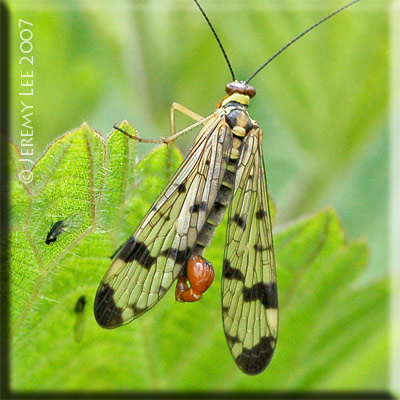
 |
|
Scientific Classifications explained » Amphibians » Ants » Aphids » Bees » Beetles » Birds » Bugs » Butterflies » Caterpillars » Damselflies » Dragonflies » Earwigs » Flies » Frog/Leafhoppers » Fungi » Galls » Grasshoppers » Harvestmen » Hoverflies » Lacewings » Ladybirds » Leaf Mines » Lichens » Mammals » Millipedes » Mosses » Moths » Sawflies » Slugs » Snails » Spiders » Trees & Shrubs » Wasps » Wild Flowers » Woodlice » Postboxes |
UK Nature > Flies > Panorpa communis

Scientific Name: Panorpa communis Common Name: Scorpion Fly Panorpa communis, more commonly known as the Scorpion Fly, has a wingspan of approximately 35mm, and is found throughout the UK. On the wing between between May and September, they are normally found in hedgerows and nettle beds. Their diet consists mostly of dead insects, which they frequently steal from the webs of spiders. Scorpion flies belong to an ancient group of insects known as 'mecopterans' which can be traced back more than 250 million years. Many people believe that butterflies and many other species of insect evolved from their ancestors. Their heads are extended into a beak-like shape, and their tiny jaws are situated at the end. Their common name derives from the end of the male's abdomen, which curls over, resembling that of a scorpion. Despite the appearance, they are perfectly harmless, and don't sting. The tip of the tail has a pair of claspers which he uses when mating with the female. |
|

https://www.uknature.co.uk is a website dedicated to showing the immense diversity of UK nature and wildlife. Our vast range of habitats, from lowland arable to snow covered mountains, from storm-ravaged coastlines to peaceful inland freshwater lakes and rivers, from dry, sandy heaths to deciduous and coniferous forests, all these habitats contribute to the abundance of UK nature. We have wild birds in huge numbers either residing or visiting our shores (597 recorded species as at July 2013) and we must also not forget the humble back garden with its grass lawns, flower beds filled with nectar rich flowers, shrubs and trees, all designed to attract huge numbers of insects such as bees, moths, butterflies and hoverflies; and finally the small ponds which provide safe havens for frogs, toads, newts and even slow worms and grass snakes. www.uknature.co.uk is the showcase for my personal passion, photographing uknature in all its glory. I sincerely hope you all enjoy the fruits of my labours. This site and all images contained therein is © Jeremy Lee 2004 - 2025. All Rights Reserved. Site design by Jeremy Lee. Site development & IT Support by Stuart Lee. |